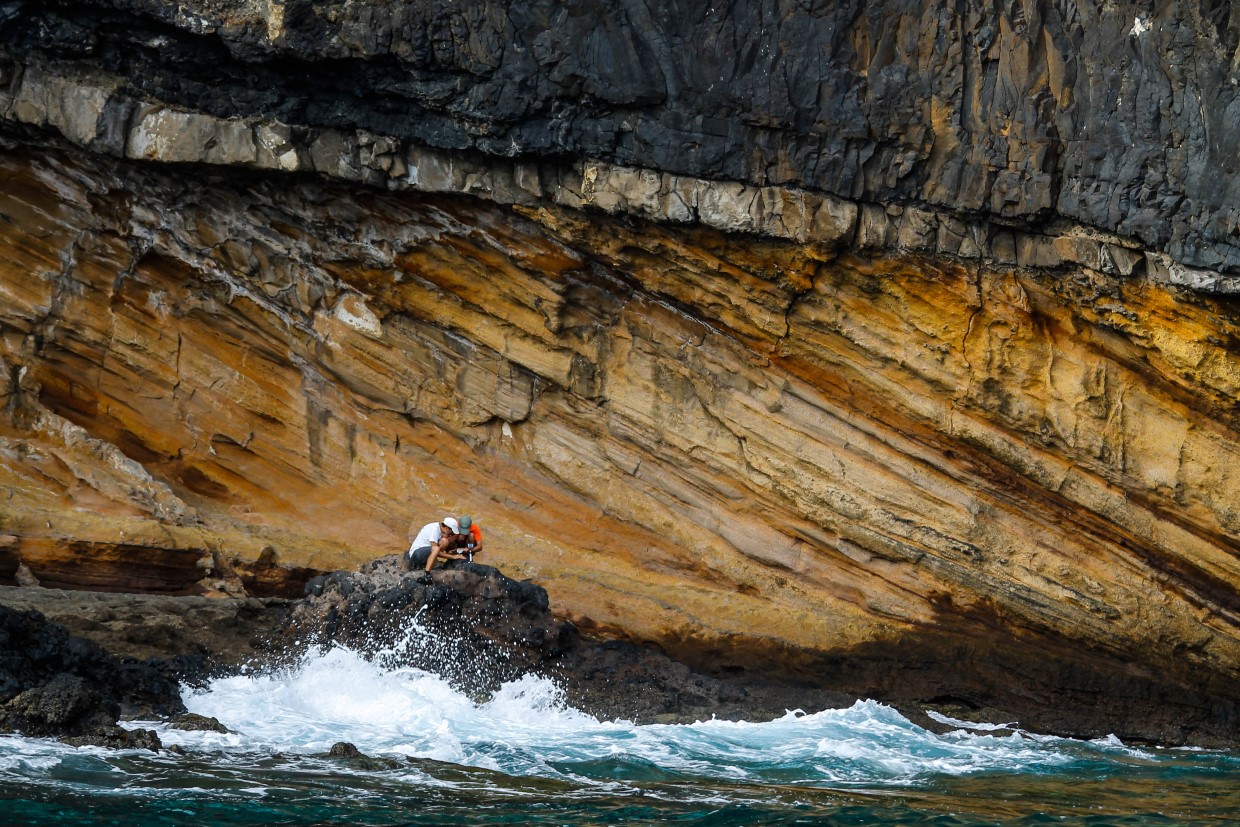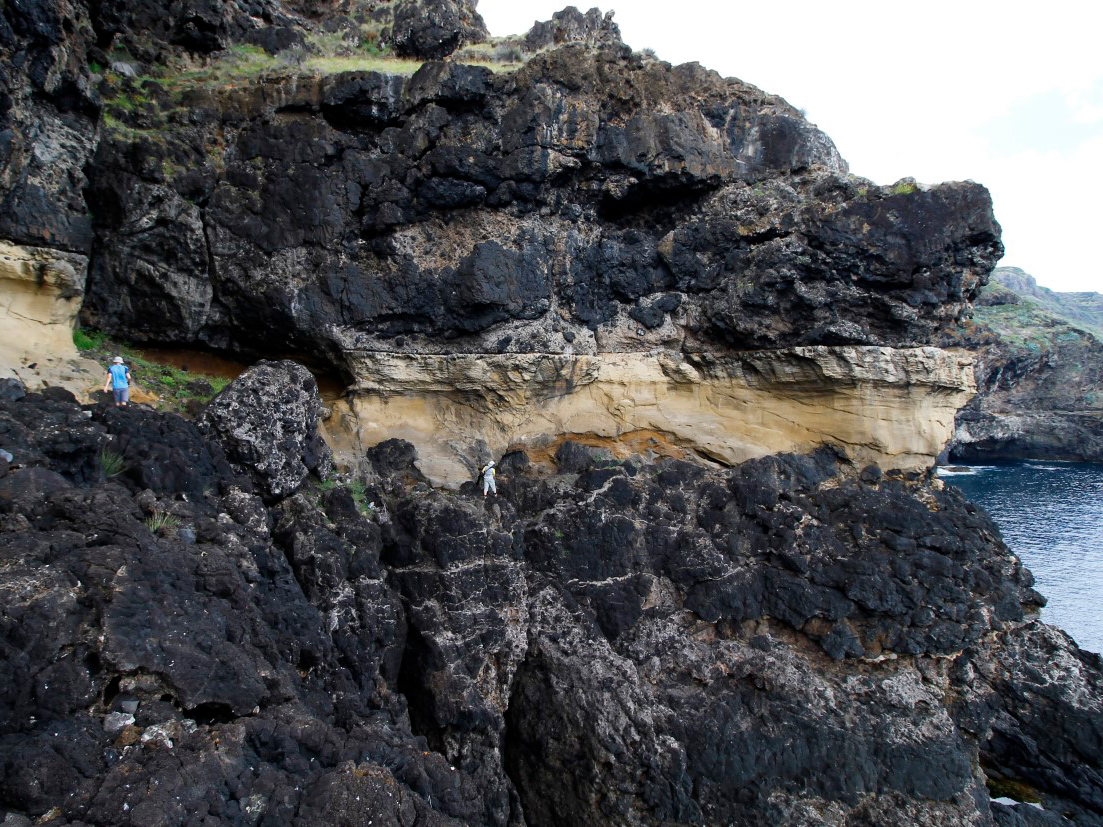Açores
O arquipélago dos Açores é o mais setentrional da Macaronésia. Composto por nove ilhas vulcânicas com idades entre os 6,01 Ma de Santa Maria (Ramalho et al., 2017) e os 0,186 Ma da jovem ilha do Pico (Costa et al., 2015), estas ilhas localizam-se entre as latitudes 36°50’ e 39°45’ N e as longitudes 31°17’ e 24°56’ O, a cerca de 1.400 km a oeste de Portugal Continental e 840 km a noroeste do arquipélago da Madeira.
Depósitos fossilíferos marinhos são conhecidos apenas em Santa Maria, a ilha mais antiga. Santa Maria é, até ao momento, a única ilha do arquipélago que apresenta sinais de soerguimento (Ramalho et al., 2017).
As sequências sedimentares marinhas bem preservadas foram depositadas durante o Pliocénico (Madeira et al., 2011; Ávila et al., 2012, 2018, 2020, 2022; Meireles et al., 2012; Hyzny et al., 2021; Sacchetti et al. , 2023) e o Pleistocénico (no Último Interglacial) (Ávila et al., 2009a, 2009b, 2010, 2015a, 2015b), oferecendo informações importantes sobre alterações na distribuição geográfica das espécies, que ocorreram nestas duas épocas (cf. Ávila et al ., 2015a, 2016; Melo et al., 2022a, 2022b).
Explore a Paleobiodiversidade dos Açores
Bibliografia
ÁVILA, S.P., P. MADEIRA, C. ZAZO, A. KROH, M. KIRBY, C. MARQUES DA SILVA, M. CACHÃO & A.M. DE FRIAS MARTINS, 2009a. Palaeoecology of the Pleistocene (MIS 5.5) outcrops of Santa Maria Island (Azores) in a complex oceanic tectonic setting. Palaeogeography, Palaeoclimatology, Palaeoecology, 274: 18–31.
ÁVILA, S.P., C. MARQUES DA SILVA, R. Schiebel, F. CECCA, T. backeljau & A. M. DE FRIAS MARTINS, 2009b. How did they get here? The biogeography of the marine molluscs of the Azores. Bulletin of the Geological Society of France, 180: 295–307.
ÁVILA, S.P., A.C. REBELO, A. MEDEIROS, C. MELO, C. GOMES, L. BAGAÇO, P. MADEIRA, P.A. BORGES, P. MONTEIRO, R. CORDEIRO, R. MEIRELES & R. RAMALHO, 2010. Os fósseis de Santa Maria (Açores). 1. A jazida da Prainha, 103 pp. OVGA – Observatório Vulcanológico e Geotérmico dos Açores, Lagoa. ISBN 978-989-8164-09-04.
ÁVILA, S.P., R. RAMALHO & R. VULLO, 2012. Systematics, palaeoecology and palaeobiogeography of the Neogene fossil sharks from the Azores (Northeast Atlantic). Annales de Paléontologie, 98: 167–189.
ÁVILA, S.P., C. MELO, L. SILVA, R. RAMALHO, R. QUARTAU, A. HIPÓLITO, R. CORDEIRO, A.C. REBELO, P. MADEIRA, A. ROVERE, P.J. HEARTY, D. HENRIQUES, C.M. DA SILVA, A.M.F. MARTINS & C. ZAZO, 2015a. A review of the MIS 5e highstand deposits from Santa Maria Island (Azores, NE Atlantic): palaeobiodiversity, palaeoecology and palaeobiogeography. Quaternary Science Reviews, 114: 126–148.
ÁVILA, S.P., R. CORDEIRO, A.R. RODRIGUES, A.C. REBELO, C. MELO, P. MADEIRA & N.D. PYENSON, 2015b. Fossil Mysticeti from the Pleistocene of Santa Maria Island, Azores (NE Atlantic Ocean), and the prevalence of fossil cetaceans on oceanic islands. Palaeontologia Electronica 18.2.27A.
ÁVILA, S.P., C. MELO, B. BERNING, R. CORDEIRO, B. LANDAU & C.M. da SILVA, 2016. Persististrombus coronatus (Mollusca: Strombidae) in the early Pliocene of Santa Maria Island (Azores: NE Atlantic): palaeoecology, palaeoclimatology and palaeobiogeographic implications on the NE Atlantic Molluscan Biogeographical Provinces. Palaeogeography, Palaeoclimatology, Palaeoecology, 441: 912–923.
ÁVILA, S.P., R. RAMALHO, J. HABERMANN & J. TITSCHACK, 2018. The marine fossil record at Santa Maria Island (Azores). In: KUEPPERS, U. & C. BEIER (Eds), Volcanoes of the Azores. Revealing the Geological Secrets of the Central Northern Atlantic Islands. Active Volcanoes of the World. Springer, Berlin, Heidelberg: 155–196.
Ávila, S.P., J.M.N. Azevedo, P. madeira, R. Cordeiro, C.S. Melo, L. Baptista, P. Torres, M.E. JOHNSON & R. vullo, 2020. Pliocene and Late-Pleistocene actinopterygian fishes from Santa Maria Island (Azores: NE Atlantic Ocean): systematics, palaeoecology and palaeobiogeography. Geological Magazine, 157 (9): 1526–1542.
ÁVILA S.P., R.S. Ramalho, C.M. da Silva, M.E. JOHNSON, A. UCHMAN, B. BERNING, R. Quartau, P. Madeira, C.S. Melo, A.c. Rebelo, l. baptista, s. arruda, E. González, M.W. RASSER, a. hipólito, R. Cordeiro, R. MEIRELES, V. RAPOSO, J. POMBO, R. CÂMARA, M.X. KIRBY, J. TITSCHACK, J.M. HABERMANN, r. vullo, A. KROH, j.h. lipps, M. CACHÃO & J. madeira, 2022. Os fósseis de Santa Maria (Açores). 2. Pedra-que-pica: uma história com 5 milhões de anos, 160 pp. OVGA – Observatório Vulcanológico e Geotérmico dos Açores, Lagoa. ISBN 978-989-8164-25-4.
COSTA, A.C.G., A. HILDENBRAND, F.O. MARQUES, A.L.R. SIBRANT & A. SANTOS DE CAMPOS, 2015. Catastrophic flank collapses and slumping in Pico Island during the last 130 kyr (Pico-Faial ridge, Azores Triple Junction). Journal of Volcanology and Geothermal Research, 302: 33–46.
HYZNY, M., C.S. MELO, R.S. RAMALHO, R. CORDEIRO, P. MADEIRA, L. BAPTISTA, A.C. REBELO, C. GÓMEZ, P. TORRES, A. UCHMAN, M.E. JOHNSON, B. BERNING & S.P. ÁVILA, 2021. Pliocene and Late Pleistocene (MIS 5e) decapod crustacean crabs from Santa Maria Island (Azores Archipelago: NE Atlantic): systematics, palaeoecology and palaeobiogeography. Journal of Quaternary Science, 36: 91–109.
MADEIRA, P., A. KROH, R. CORDEIRO, R. MEIRELES & S.P. ÁVILA, 2011. The fossil echinoids of Santa Maria island, Azores (northern Atlantic ocean). Acta Geologica Polonica, 61: 243–264.
MEIRELES, R.P., C. FARANDA, E. GLIOZZI, A. PIMENTEL, V. ZANON & S.P. ÁVILA, 2012. Late Miocene marine ostracods from Santa Maria Island, Azores (NE Atlantic): Systematics, palaeoecology and palaeobiogeography. Révue de Micropaléontologie, 55: 133–148.
MELO, C.S., E. MARTÍN-GONZÁLEZ, C.M. da SILVA, I. GALINDO, A. GONZÁLEZ-RODRÍGUEZ, L. BAPTISTA, A.C. REBELO, P. MADEIRA, A.H.L. VOELKER, M.E. JOHNSON, S.A. ARRUDA & S.P. ÁVILA, 2022. Range expansion of tropical shallow-water marine molluscs in the NE Atlantic during the last interglacial (MIS 5e): Causes, consequences and utility of ecostratigraphic indicators for the Macaronesian archipelagos. Quaternary Science Reviews, 278: 107377.
MELO, C.S., E. MARTÍN-GONZÁLEZ, C.M. da SILVA, I. GALINDO, A. GONZÁLEZ-RODRÍGUEZ, L. BAPTISTA, A.C. REBELO, P. MADEIRA, A.H.L. VOELKER, M.E. JOHNSON, S.A. ARRUDA & S.P. ÁVILA, 2022. Reply to the comment by Meco et al. on “Range expansion of tropical shallow-water marine molluscs in the NE Atlantic during the last interglacial (MIS 5e): Causes, consequences and utility of ecostratigraphic indicators for the Macaronesian archipelagos”. Quaternary Science Reviews, 288: 107535.
RAMALHO, R.S., G. HELFFRICH, J. MADEIRA, M. COSCA, C. THOMAS, R. QUARTAU, A. HIPÓLITO, A. ROVERE, P.J. HEARTY & S.P. ÁVILA, 2017. The emergence and evolution of Santa Maria Island (Azores) – the conundrum of uplifted islands revisited. Bulletin of the Geological Society of America, 129 (3/4): 372–391.
SACCHETTI, C., B. LANDAU & S.P. ÁVILA, 2023. The Lower Pliocene marine gastropods of Santa Maria Island, Azores: Taxonomy and palaeobiogeographic implications. Zootaxa, 5295(1): 1–150.
Como citar:
MPDb (2023). Açores. Base de dados da Paleobiodiversidade da Macaronésia. https://macpaleo.uac.pt/pt/acores/














